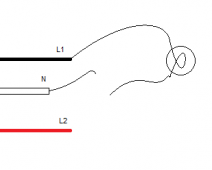I should have been paying more attention category.
I am in the process of setting up a AIO powering a sub panel with critical loads. I wanted to be able to switch the panel back to the mains if there was a problem with the AIO setup. So I wired up a manual transfer switch with both the positive and neutral being switched. Only one problem I forgot to actually connect the wire to the neutral from the main. Should have let the coffee this morning work a bit longer. So when I flipped the power on for a quick test I had open neutral conditions. This in itself would have been OK since I had thought I had off all loads but I did not. There was a surge protector power strip with a wall wart charger that I had neglected to unplug.
Bzap! I immediately flip the power back off and start to figure out what I had screwed up. The surge strip is toast although the wall wart appears OK.
Not the most brilliant thing I have done.
I am in the process of setting up a AIO powering a sub panel with critical loads. I wanted to be able to switch the panel back to the mains if there was a problem with the AIO setup. So I wired up a manual transfer switch with both the positive and neutral being switched. Only one problem I forgot to actually connect the wire to the neutral from the main. Should have let the coffee this morning work a bit longer. So when I flipped the power on for a quick test I had open neutral conditions. This in itself would have been OK since I had thought I had off all loads but I did not. There was a surge protector power strip with a wall wart charger that I had neglected to unplug.
Bzap! I immediately flip the power back off and start to figure out what I had screwed up. The surge strip is toast although the wall wart appears OK.
Not the most brilliant thing I have done.





